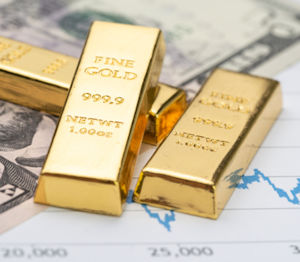
Hedge Against Inflation?
One of the primary reasons investors turn to precious metals is that they have a reputation for holding their value over the very long term, even as inflation erodes the purchasing power of paper currencies. However, in the short run, they can fluctuate considerably. But they can still help protect your wealth during periods of economic uncertainty. In my article Is Gold Really a Hedge? I demonstrate that gold is really more of a crisis hedge than an inflation hedge, meaning that when things get really bad, gold not only holds its value but can actually increase in value... while everything else is falling like a rock.
Portfolio Diversification
Portfolio diversification is a crucial investment tactic, and many financial advising services, suggest incorporating precious metals a smart choice.
In finance, there is a concept called a "correlation coefficient." which simply means how closely two different investments track each other.
According to Investopedia: "The further the coefficient is from zero, whether it is positive or negative, the better the fit and the greater the correlation. The values of -1 (for a negative correlation) and 1 (for a positive one) describe perfect fits in which all data points align in a straight line, indicating that the variables are perfectly correlated. In other words, the relationship is so predictable that the value of one variable can be determined from the matched value of the other. The closer the correlation coefficient is to zero the weaker the correlation, until at zero no linear relationship exists at all."
In other words, if two items have a correlation coefficient of "1" they move exactly identically. If they have a correlation coefficient of of "-1" they move exactly opposite and if they have a correlation coefficient of zero their movements are entirely unrelated.
The typical pair used in investing are stocks and bonds. see: 60% stocks, 40% bonds? Although stocks and bonds are not entirely inversely correlated to each other, they do tend to balance each other out.
But by adding precious metals to the mix the overall performance is greatly enhanced. Their low correlation with other investment types, such as stocks and bonds, makes them an ideal addition to a portfolio. By including precious metals, investors can potentially lessen risk and increase the stability of their investments. It's a smart move that hedges bets against market volatility and is a tried-and-true approach to creating a winning portfolio.
Fisher Capital Group, suggests that including precious metals in an IRA can help with tax deferment. They also say, "Debt-based assets are often not backed with collateral. Gold is a tangible asset you hold in your hand." In other words, most investments today include an element of risk because every paper asset is someone else's liability and is thus subject to some risk of default. Physical metals however are unique in that there is no counter party risk.
Store of Value
Precious metals are finite resources, unlike paper currency that can be printed at will. This means that governments or central banks cannot easily manipulate them. Gold and silver have been used as a store of value for centuries, which remains true today. Precious metals are tangible assets that can be held outside the traditional banking system, providing additional protection and security to your financial portfolio.
Significant Returns
While precious metals can be a lower-risk investment, they also have the potential to provide significant returns. For example, the price of gold has increased by over 300% in the last decade, with silver experiencing similar gains. Investing in precious metals can offer significant long-term growth potential.
Crisis Protection
In times of economic turmoil, precious metals have historically performed well. They provide a safe haven for investors looking to protect themselves from market volatility and uncertainty. Precious metals have a track record of holding their value during periods of crisis, making them a valuable addition to any investment portfolio.
By adding precious metals to your financial portfolio, you can diversify your investments, hedge against inflation, protect your wealth, potentially earn significant returns, and protect your portfolio in times of crisis. While building a portfolio that includes precious metals does require effort and research on your part, it is an investment that can provide substantial benefits in the long term. Consider speaking with a financial advisor to learn more about how you can add precious metals to your portfolio and begin to reap the benefits of this valuable investment.
See also:
